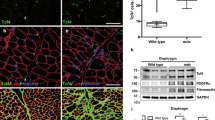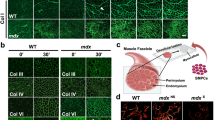Abstract
Treatment with vascular endothelial growth factor (VEGF) to reduce ischemia and enhance both endogenous muscle repair and regenerative cell therapy in Duchenne muscular dystrophy (DMD) has been widely proposed in recent years. However, the interaction between angiogenesis and fibrosis, a hallmark feature of DMD, remains unclear. To date, it has not been determined whether VEGF exerts a pro-fibrotic effect on DMD-derived fibroblasts, which may contribute to further disease progression. Thus, the purpose of this study was to investigate the effect of exogenous VEGF on fibroblast cultures established from a murine model of DMD. Primary fibroblast cultures were established from gastrocnemius and diaphragm muscles of 10 week-old mdx/utrn+/- mice. Quantitative polymerase chain reaction (qPCR) was employed to assess changes in transcript expression of alpha-smooth muscle actin (Acta2), type-1 collagen (Col1a1), connective tissue growth factor (Ctgf/ccn2) and fibronectin (Fn1). Immunofluorescence and Western blot analysis was further employed to visualize changes in protein expression of alpha-smooth muscle actin (α-SMA), CTGF/CCN2 and fibronectin. mRNA levels of Col1a1, Ctgf/ccn2, and FN did not increase following treatment with VEGF in fibroblasts derived from either diaphragm or gastrocnemius muscles. Acta2 expression increased significantly in diaphragm-derived fibroblasts following treatment with VEGF. Morphological assessment revealed increased stress fiber formation in VEGF-treated fibroblasts compared to the untreated control fibroblasts. The findings from this study suggest that further investigation into the effect of VEGF on fibroblast function is required prior to the utilization of the growth factor as a treatment for DMD.



Similar content being viewed by others
Abbreviations
- DMD:
-
Duchenne muscular dystrophy
- VEGF:
-
Vascular endothelial growth factor
- TGFβ:
-
Transforming growth factor beta
- Col1a1 :
-
Type I collagen (mRNA)
- αSMA:
-
Alpha-smooth muscle actin
- Acta2 :
-
Alpha-smooth muscle actin (mRNA)
- Ctgf/ccn2 :
-
Connective tissue growth factor (mRNA)
- CTGF/CCN2:
-
Connective tissue growth factor
- Fn1 :
-
Fibronectin (mRNA)
- FN:
-
Fibronectin
- qPCR:
-
Quantitative polymerase chain reaction
References
Arsic N, Zacchigna S, Zentilin L, Ramirez-Correa G, Pattarini L, Salvi A et al (2004) Vascular endothelial growth factor stimulates skeletal muscle regeneration in vivo. Mol Ther 10:844–854
Astrof S, Hynes RO (2009) Fibronectins in vascular morphogenesis. Angiogenesis 12(2):165–175
Beckman SA, Chen WC, Tang Y, Proto JD, Mlakar L, Wang B et al (2013) Beneficial effect of mechanical stimulation on the regenerative potential of muscle-derived stem cells is lost by inhibiting vascular endothelial growth factor. Arterioscler Thromb Vasc Biol 33(8):2004–2012
Bernasconi P, Torchiana E, Confalonieri P, Brugnoni R, Barresi R, Mora M et al (1995) Expression of transforming growth factor-beta 1 in dystrophic patient muscles correlates with fibrosis. Pathogenetic role of a fibrogenic cytokine. J Clin Invest 96(2):1137–1144
Borselli C, Storrie H, Benesch-Lee F, Shvartsman D, Cezar C, Lichtman JW et al (2010) Functional muscle regeneration with combined delivery of angiogenesis and myogenesis factors. Proc Natl Acad Sci U S A 107:3287–3292
Bouchentouf M, Benabdallah BF, Bigey P, Yau TM, Scherman D, Tremblay JP (2008) Vascular endothelial growth factor reduced hypoxia-induced death of human myoblasts and improved their engraftment in mouse muscles. Gene Ther 6:404–414
Chen YW, Nagaraju K, Bakay M, McIntyre O, Rawat R, Shi R et al (2005) Early onset of inflammation and later involvement of TGFbeta in Duchenne muscular dystrophy. Neurology 65(6):826–834
Deasy BM, Feduska JM, Payne TR, Li Y, Ambrosio F, Huard J (2009) Effect of VEGF on the regenerative capacity of muscle stem cells in dystrophic skeletal muscle. Mol Ther 17:1788–1798
Deconinck AE, Rafael JA, Skinner JA, Brown SC, Potter AC, Metzinger L et al (1997) Utrophin-dystrophin-deficient mice as a model for Duchenne muscular dystrophy. Cell 90(4):717–727
Desguerre I, Mayer M, Leturcq F, Barbet JP, Gherardi RK, Christov C (2009) Endomysial fibrosis in Duchenne muscular dystrophy: a marker of poor outcome associated with macrophage alternative activation. J Neuropathol Exp Neurol 68:762–773
Desguerre I, Arnold L, Vignaud A, Cuvellier S, Yacoub-Youssef H, Gherardi RK et al (2012) A new model of experimental fibrosis in hindlimb skeletal muscle of adult mdx mouse mimicking muscular dystrophy. Muscle Nerve 45(6):803–814
Goerges AL, Nugent MA (2004) pH regulates vascular endothelial growth factor binding to fibronectin: a mechanism for control of extracellular matrix storage and release. J Biol Chem 279:2307–2315
Goyenvalle A, Babbs A, Powell D, Kole R, Fletcher S, Wilton SD et al (2010) Prevention of dystrophic pathology in severely affected dystrophin/utrophin-deficient mice by morpholino-oligomer-mediated exon-skipping. Mol Ther 18(1):198–205
Goyenvalle A, Babbs A, Wright J, Wilkins V, Powell D, Garcia L et al (2012) Rescue of severely affected dystrophin/utrophin-deficient mice through scAAV-U7snRNA-mediated exon skipping. Hum Mol Genet 21(11):2559–2571
Grady RM, Merlie JP, Sanes JR (1997a) Subtle neuromuscular defects in utrophin-deficient mice. J Cell Biol 136(4):871–882
Grady RM, Teng H, Nichol MC, Cunningham JC, Wilkinson RS, Sanes JR (1997b) Skeletal and cardiac myopathies in mice lacking utrophin and dystrophin: a model for Duchenne muscular dystrophy. Cell 90(4):729–738
Gregorevic P, Blankinship MJ, Allen JM, Crawford RW, Meuse L, Miller DG et al (2004) Systemic delivery of genes to striated muscles using adeno-associated viral vectors. Nat Med 10(8):828–834
Gutpell KM, Hrinivich WT, Hoffman LM (2015) Skeletal muscle fibrosis in the mdx/utrn+/- mouse validates its suitability as a murine model of Duchenne muscular dystrophy. PLoS ONE 10(1):e0117306
Hostettler KE, Zhong J, Papakonstantinou E, Karakiulakis G, Tamm M, Seidel P et al (2014) Anti-fibrotic effects of nintedanib in lung fibroblasts derived from patients with idiopathic pulmonary fibrosis. Respir Res 15:157–166
Huang P, Cheng G, Lu H, Aronica M, Ransohoff RM, Zhou L (2011) Impaired respiratory function in mdx and mdx/utrn(+/-) mice. Muscle Nerve 43(2):263–267
Konieczny P, Swiderski K, Chamberlain JS (2013) Gene and cell-mediated therapies for muscular dystrophy. Muscle Nerve 47(5):649–663
Kuiper EJ, Hughes JM, Van Geest RJ, Vogels I, Goldschmeding R, Van Noorden C et al (2007) Effect of VEGF-A on expression of profibrotic growth factor and extracellular matrix genes in the retina. Invest Ophthalmol Vis Sci 48(9):4267–4276
Maurer B, Distler A, Suliman YA, Gay RE, Michel BA, Gay S et al (2014) Vascular endothelial growth factor aggravates fibrosis and vasculopathy in experimental models of systemic sclerosis. Ann Rheum Dis 73(10):1880–1887
Messina S, Mazzeo A, Bitto A, Aguennouz M, Migliorato A, De Pasquale MG et al (2007) VEGF overexpression via adeno-associated virus gene transfer promotes skeletal muscle regeneration and enhances muscle function in mdx mice. FASEB J 21(13):3737–3746
Mezzano V, Cabrera D, Vial C, Brandan E (2007) Constitutively activated dystrophic muscle fibroblasts show a paradoxical response to TGF-β and CTGF/CCN2. J Cell Commun Signal 1(3):205–217
Miyazaki D, Nakamura A, Fukushima K, Yoshida K, Takeda S, Ikeda S (2011) Matrix metalloproteinase-2 ablation in dystrophin-deficient mdx muscles reduces angiogenesis resulting in impaired growth of regenerated muscle fibers. Hum Mol Genet 20(9):1787–1799
Pessina P, Cabrera D, Morales MG, Riquelme CA, Gutiérrez J, Serrano AL et al (2014) Novel and optimized strategies for inducing fibrosis in vivo: focus on Duchenne muscular dystrophy. Skelet Muscle 4:7
Rhoads RP, Flann KL, Cardinal TR, Rathbone CR, Liu X, Allen RE (2013) Satellite cells isolated from aged or dystrophic muscle exhibit a reduced capacity to promote angiogenesis in vitro. Biochem Biophys Res Commun 440(3):399–404
Shimizu-Motohashi Y, Asakura A (2014) Angiogenesis as a novel therapeutic strategy for Duchenne muscular dystrophy through decreased ischemia and increased satellite cells. Front Physiol 5:50
Stedman HH, Sweeney HL, Shrager JB, Maguire HC, Panettieri RA, Petrof B et al (1991) The mdx mouse diaphragm reproduces the degenerative changes of Duchenne muscular dystrophy. Nature 352(6335):536–539
Taylor SC, Berkelman T, Yadav G, Hammond M (2013) A defined methodology for reliable quantification of western blot data. Mol Biotechnol 55(3):217–226
van Putten M, Kumar D, Hulsker M, Hoogaars WM, Plomp JJ, van Opstal A et al (2012) Comparison of skeletal muscle pathology and motor function of dystrophin and utrophin deficient mouse strains. Neuromuscul Disord 22(5):406–417
Vempati P, Popel AS, Mac Gabhann F (2014) Extracellular regulation of VEGF: isoforms, proteolysis, and vascular patterning. Cytokine Growth Factor Rev 25(1):1–19
Wijelath ES, Murray J, Rahman S, Patel Y, Ishida A, Strand K et al (2002) Novel vascular endothelial growth factor binding domains of fibronectin enhance vascular endothelial growth factor biological activity. Circ Res 91:25–31
Wijelath ES, Rahman S, Murray J, Patel Y, Savidge G, Sobel M (2004) Fibronectin promotes VEGF-induced CD34 cell differentiation into endothelial cells. J Vasc Surg 39:655–660
Zhou L, Rafael-Fortney JA, Huang P, Zhao XS, Cheng G, Zhou X et al (2008) Haploinsufficiency of utrophin gene worsens skeletal muscle inflammation and fibrosis in mdx mice. J Neurol Sci 264(1–2):106–111
Acknowledgments
We would like to thank Dr. Robert Grange from Virginia Tech, Virginia for generously providing us with the mdx/utrn+/- mice. We would also like to acknowledge Terrie Ann and Dale Forder at the St. Joseph’s Animal Care Facility for assistance with animal care and Dr. Justin Crawford for technical assistance.
Author contributions
KG carried out the experimental work and performed the statistical analysis. KG and LH conceived and designed the study and drafted the manuscript. Both authors read and approved the final manuscript.
Author information
Authors and Affiliations
Corresponding author
Rights and permissions
About this article
Cite this article
Gutpell, K.M., Hoffman, L.M. VEGF induces stress fiber formation in fibroblasts isolated from dystrophic muscle. J. Cell Commun. Signal. 9, 353–360 (2015). https://doi.org/10.1007/s12079-015-0300-z
Received:
Accepted:
Published:
Issue Date:
DOI: https://doi.org/10.1007/s12079-015-0300-z




